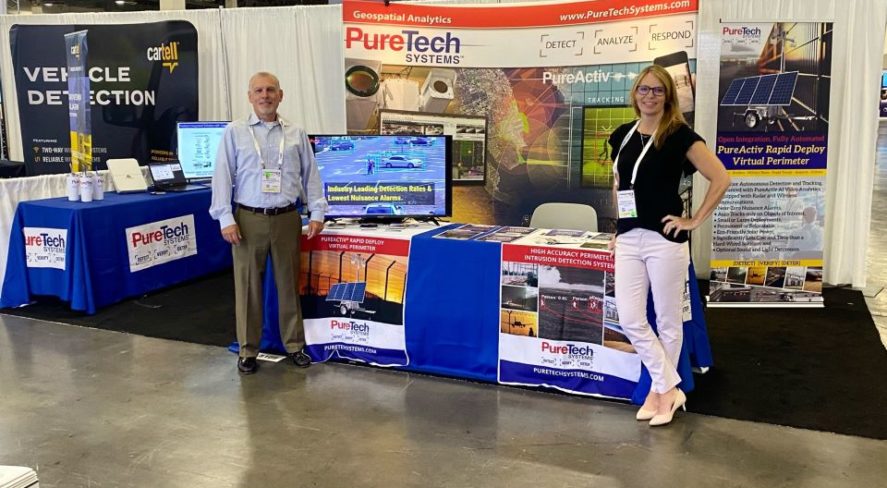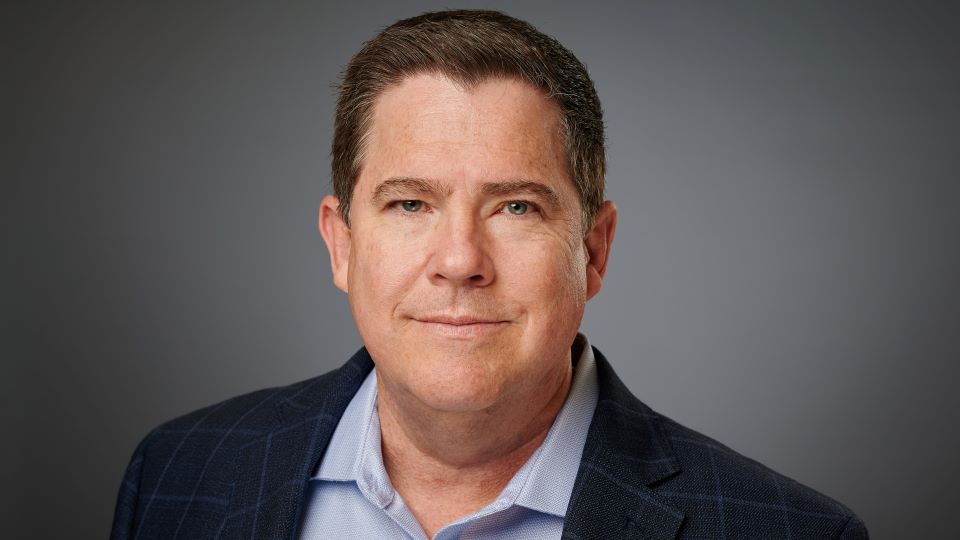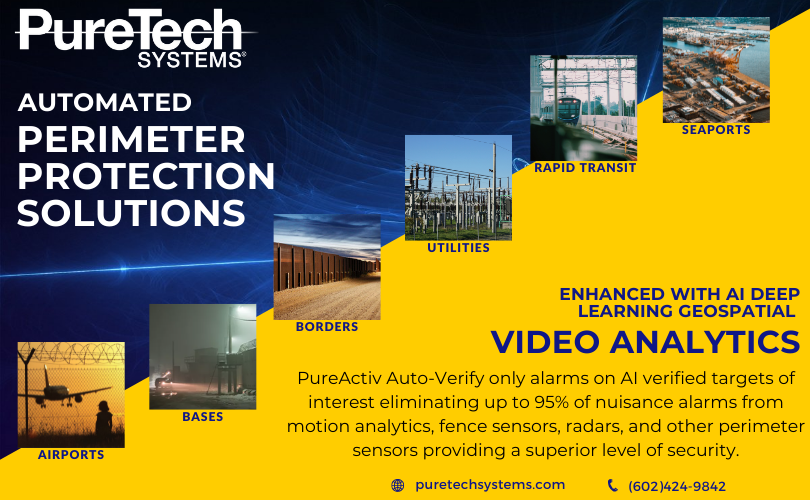SIA New Member Profile: PureTech Systems

New Security Industry Association (SIA) member PureTech Systems Inc. is a privately owned technology corporation established in 2004 and a leader in the location and machine learning/deep learning-based artificial intelligence (AI) video analytics market, with a focus on applications involving security of critical infrastructure and false alarm reduction for video central monitoring stations, where it offers its AI video analytics as a service. PureTech is headquartered in Phoenix, Arizona.
SIA spoke with Larry Bowe, Jr., president and CEO of PureTech Systems, about the company, the security industry and working with SIA.

Tell us the story of your company.
Larry Bowe, Jr.: The initial portfolio of technologies used to launch the business came from a Canadian company by the name of Pure Technologies (Pure) in 2004. Pure was largely in the business of non-destructive acoustic monitoring of structures such as water pipes and bridge cable stays required to assess if otherwise hidden corrosion was occurring. Subsequent to 9/11, Pure’s bridge customers started asking them if they could also employ video analytics to detect if someone was attempting to harm a bridge, as it would obviously be too late once an explosion had occurred. Given Pure’s successful experience in the business of securing and analyzing acoustic signals and geolocating their occurrence on a real-time basis, Pure quickly developed the new video analytics capability required to address their bridge customers’ needs. But surveillance, itself, was not core to their business.
I was working for Verint Video Solutions as the vice president of product management and business development, a role which included assessing potential acquisition candidates. Pure approached me about Verint’s potential interest in acquiring their technology. At that time, Verint was focused on the integration of a couple of recent acquisitions into their business – namely SmartSight and Lanex – and therefore was not interested in acquiring Pure’s relevant assets. I could see the potentially broader utility in their technology and decided to join forces with Pure to spearhead a new company. In early 2005, Pure and I formed a new subsidiary of Pure Technologies and named it PureTech Systems Inc. incorporated in Arizona. A couple years into the business, having solid initial market success, Pure sold PureTech Systems assets to IcX Technologies. In mid-2010, prior to IcX selling to FLIR, a few key employees and I bought out PureTech Systems from IcX. For the past 11 years, PureTech Systems Inc. (PureTech) has operated as a standalone business with the consistent mission of providing and enabling the world’s best autonomous video surveillance systems and solutions for critical infrastructure perimeters and border protection. PureTech’s laser-like focus upon continuous innovation, customer requirements and real-world fielded performance has resulted in the issuance of 14 U.S. patents but, more importantly, has continued to help new and existing customers to more efficiently and effectively protect their critical infrastructure and national borders.
What solutions/services does your business offer in the security industry? And what makes your offerings/company unique?
LB: PureTech Systems Systems develops, markets and supports its patented location-based AI video analytics and detection sensor integration software, PureActiv, for real-time safety and security applications. Our company’s software improves situational awareness with AI video analytics, sensor integration and information fusing for automated real-time event detection with primary emphasis on automated intrusion detection and camera tracking for securing borders and coastlines, facility perimeters and critical infrastructures (airports, seaports, utilities, rapid transit, substations, power plants and military bases, among others). Our patented video analytics software, PureActiv, automatically detects, classifies, geolocates and alarms only on valid threats, thus reducing false alarms by as much as 95%.
With 16 years of innovation and successful real-world deployments, PureTech has the experience and knowledge to provide scenario-driven tailored solutions for its customers in various targeted markets. From border security to critical infrastructure protection, PureTech works together with its customers to prioritize their needs in a way that meets both performance and cost requirements.
From the beginning, PureActiv was developed with sensor and user interface integration in mind. PureActiv effectively integrates with newly-added and already-deployed cameras, radars, fence sensors and other detection devices to provide a complete intrusion detection solution integrated with their existing network video recorder or physical security information management user interface. What makes our approach unique is that a combination of traditional video analytics methods with the latest achievements in AI/deep learning (DL) in one integrated suite enables customers to substantially improve their perimeter security and situational awareness while minimizing disruptions or changes to day-to-day operations.
What is something we might not know about your company – or something new you are doing in security?
LB: On the face of it, this may seem like an ill-advised business practice, but until more recently, we have not invested in sales and marketing. An engineering company at its core, our business has come from customer and partner referrals. I’ve heard new customers and people in the industry refer to PureTech as one of the “best kept secrets” in the market. Only recently have we begun investing more heavily in sales and marketing. The timing of this was actually intentional, as early on we chose to focus more on improving the performance and supportability of the technology and only began increasing our selling and marketing efforts when, consistent with our vision, we felt we could support and sustain more rapid growth. We did not want to succumb, as so many of our competitors have, to the trap of “overpromising and underdelivering.” Of course, many of those companies have come and gone. I imagine everyone can think of a few video analytics companies, some “household” names, that have fallen into this category. We work hard every day to deliver on our commitments, which I believe is reflective in our customers staying with our technology and company for years, including many of which were among our first installations.

What is your company’s vision, and what are your goals for the security industry?
LB: PureTech Systems’ corporate vision statement has remained the same since the founding of the business. We strive to be the market leader in automated wide-area surveillance and perimeter protection systems that enable our customers to more efficiently and effectively secure, monitor and control large and remote sites.
We provide these systems to customers in select commercial and government market segments where we can gain and maintain a strong position by providing differentiated products that:1) improve operational efficiencies and effectiveness and are 2) highly reliable, 3) simple to configure and 4) easy to customize.
We will serve markets where we can achieve sufficient critical mass to support our commitment to outstanding customer support.
What do you think are the biggest opportunities in the security industry right now?
LB: One of our customers’ top priorities is to resolutely protect Americans from terrorism and other homeland security threats by preventing nation-states and their proxies, transnational criminal organizations and groups or individuals from engaging in terrorist or criminal acts that threaten the homeland. To address that alone creates a sea of opportunities that we have been addressing all along.
As we review the security events of just the last five years, we see huge role innovative technologies play in the area of collection, analysis and sharing actionable intelligence, PureTech has successfully contributed to all of these elements, including our latest very successful foray into dissemination of intelligence across the enterprise from the field agents to the enterprise leadership.
What are your predictions for the security industry in the short and long term?
LB: In my lifetime, I don’t think there has been a more exciting time to be in the technology field, and I think computer vision and AI applied to it are among the most rapidly advancing technology fields. We are witnessing its use in a broad array of industries from medicine to driverless cars. Of course, as with any rapidly advancing technology, this brings about many opportunities and many challenges. Some of your readers may have heard of Andrew Ng. He is noted as one of the foremost experts on artificial intelligence. Mr. Ng is currently an adjunct professor at Stanford University, and previously he was the director of their AI Lab. He was also the co-founder and head of Google Brain. So, when it comes to AI, I think he is someone worth listening to. Andrew is credited with stating that “AI is the new electricity.” He went on to explain that “Just as electricity transformed almost everything 100 years ago, today I actually have a hard time thinking of an industry that I don’t think AI will transform in the next several years.” Certainly, like many other industries, the security industry is being transformed by the rapid advancements in AI.
I believe, especially when applied to video, AI, and DL in particular, is enabling security software and product companies to finally deliver on the promise of high detection and recognition accuracy with very low nuisance events. I recall after 9/11 there was a rush to implement facial recognition software, and by and large, it didn’t work except in very constrained areas and environments. But now we are seeing DL applied to many video-based solutions such as facial and license plate recognition, real-time object detection and classification and forensic search tools. We will continue to see AI applied to improve the performance of existing products and use cases and entirely new sets of products, solutions and applications that people have yet to imagine.
With regard to systems that in real time detect, classify, geolocate and track people, vehicles and other objects of interest that may pose threats, which is PureTech’s area of expertise, DL alone is not sufficient. We know that AI makes mistakes. We’ve seen the head a person twice the size of Godzilla be detected in vegetation or in a busy city scene. We’ve all heard of the driverless car accidents that have occurred. We at PureTech are realizing dramatic improvements in system accuracy when we blend the use of DL with our patented classical methods of computer vision and tracking. As with any problem that has a level of complexity, it generally takes a systems approach to adequately address the problem.
A promising use of AI for physical security and other industries is in trend analysis. We hear this referred to as “Big Data.” As an example, metadata generated from the vast amount of surveillance video analytics and access control transactions from a site, such as an airport or even multiple airports, could be analyzed by AI systems to attempt to predict and, ultimately, prevent terrorist events. This may sound like science fiction, but neural nets are already being used for a vast number of purposes, such as to predict the stock market, to assess insurance risks and for airplane equipment preventative maintenance.
What are the biggest challenges facing your company and/or others in the security industry?
LB: Over the last two decades, the security industry has seen a lot of video analytics companies come and go that overpromised and underdelivered. Unfortunately, there have been a lot of unfulfilled promises of solutions. And now we are seeing a whole new batch of “gold rush” investment firms and start-ups entering the surveillance market looking to make a fast buck and, yet again, making all kinds of grandiose claims and promises.
In many ways, using computer vision and AI (i.e., video analytics) to address security threats is a much more complicated problem than many other classical uses of computer vision, such as its use in automated manufacturing and quality assurance (QA). In those use cases, the environment, such as lighting and background, are entirely known and controlled. And the task at hand, such as electronic parts placement, robotic welding or QA inspection, is well defined. Exceptions to standards can easily be automatically recognized. The environments and exceptions (i.e., threats) in surveillance use cases such as perimeter protection are highly variable and cannot be controlled. We are at the mercy of mother nature with ever-changing lighting, visibility and motion from vegetation, all of which need to be ignored. The adversaries have also become more sophisticated and able to develop the disguise techniques to counter all those detection methods.
Being in the industry for 20+ years, we understand how hard it is for customers to separate the wheat from the chaff when it comes to video analytics products. To help customers in their product selection process, out of necessity, we developed a robust system performance test method and process for assessing the actual performance of perimeter intrusion detection systems. When completed, the customer has the key performance measures, such as probability of detection and nuisance alarm rate, they need to be confident in their selection decision and be able to rest assured that their facilities and critical infrastructure is better protected. It takes some effort and discipline to perform such testing, but in the end, it’s worth it. It can help avoid spending thousands of dollars on a system that is just ignored because it continuously generates hundreds, if not thousands, of nuisance alarms a day.
Another trend we are seeing in the market is camera companies incorporating analytics into their cameras. While this may seem like a good idea, it does have its own challenges. The capabilities of AI algorithms and the compute architectures and resources they require are changing rapidly. Camera manufacturers are faced with the challenge of designing camera products that have a reasonable life; say at least five years. The compute resources AI algorithms in use today versus six to 12 months from now can easily increase by 50% or even double. New inventive commercial off-the-shelf hardware by companies such as Qualcomm, Nvidia, Intel and Ambarella is rapidly evolving. In my opinion, the technology is changing too fast right now to get locked into a camera that likely must be replaced in a year or two if you want to improve the accuracy and features of the video analytics. A better option, at least for the next few years, may be to host the analytics in Internet of Things edge devices and/or servers, which generally can be more easily upgraded. You don’t have to hire a bucket crew to upgrade an edge device or server like you do to replace and recalibrate a camera. Ultimately, just as digital encoders made their way from edge devices into the cameras, so will a certain class of video analytics. But there will remain a number of multicamera, multisensor and other video analytics AI system functions that just cannot be achieved at the camera level. These will continue to need to be done on edge devices, on-prem servers and in the cloud.
What do you enjoy most about being at your company – and in the security industry?
LB: We recently conducted an all-employee poll, and one of the questions we asked was what employees liked about working at PureTech. There were a couple of common replies that stood out. One was that employees feel they make a difference – that we are addressing customer problems and they could see how their efforts directly benefited the customer and, at times, the safety of our nation. Part of this is that we are a relatively small company, but even as we grow, one of our corporate values is to continue to have a culture that focuses externally at addressing the ever-changing problems of our customers.
We will continue to ensure employees across all functions are close the customer and even hear directly from them about their issues and collaborate to address them. Another common response was that employees felt that while performance expectations were high, the company understands the importance of work/home life balance and provides flexibility, when possible, to ensure family remains a priority.
What does SIA offer that is most important to you/your company? And what do you most hope to get out of your membership with SIA?
LB: We are excited to have recently joined SIA as a member. The breakout sessions and roundtable events offered at ISC West will allow us to learn about new and developing changes and challenges in industry guided conversations. Those will enable us to better understand the ever-changing security world needs and tune our own solutions to those needs. We also look forward to attending future networking events and meeting like-minded companies that could potentially be integration partners. Our marketing director has also recently joined the SIA Women in Security Forum, and we are looking forward to supporting the involvement of women in the security industry.
The views and opinions expressed in guest posts and/or profiles are those of the authors or sources and do not necessarily reflect the official policy or position of the Security Industry Association.
